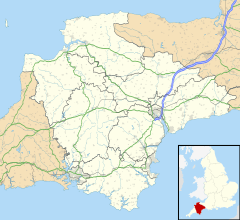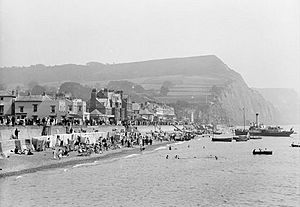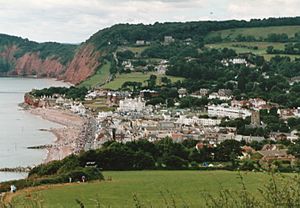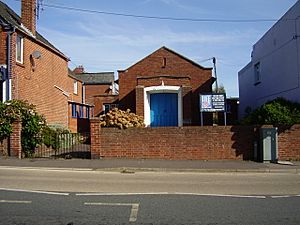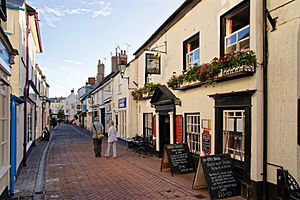Sidmouth facts for kids
Quick facts for kids Sidmouth |
|
|---|---|
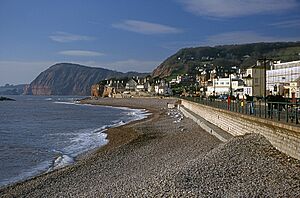 Looking west along Sidmouth beach |
|
 Coat of arms |
|
| Population | 12,569 |
| OS grid reference | SY124874 |
| District |
|
| Shire county | |
| Region | |
| Country | England |
| Sovereign state | United Kingdom |
| Post town | Sidmouth |
| Postcode district | EX10 |
| Dialling code | 01395 |
| Police | Devon and Cornwall |
| Fire | Devon and Somerset |
| Ambulance | South Western |
| EU Parliament | South West England |
| UK Parliament |
|
| Website | visitdevon.co.uk/sidmouth |
Sidmouth (/ˈsɪdməθ/) is a beautiful town on the English Channel in Devon, South West England. It's about 14 miles (23 km) southeast of Exeter. In 2021, about 13,258 people lived there. Sidmouth is a popular place for tourists to visit. It's also a main entry point to the amazing Jurassic Coast World Heritage Site. A big part of the town is a special "conservation area." This means its historic buildings and natural beauty are protected.
Contents
History of Sidmouth
Sidmouth has a very long history, even before records were kept. People have lived in the Sid valley since at least the Iron Age. You can see proof of this at Sidbury Castle. There might have been people here even earlier. Bronze Age burial mounds (old graves) have been found on nearby hills.
The village of Sidbury started in Saxon times. Its church crypt (an underground room) is from the 7th century. Sidmouth itself was first a small fishing village. It is mentioned in the Domesday Book of 1086. Its name, Sedemuda, means "mouth of the Sid".
By the 1200s, Sidmouth grew into a market town. It became as big as Sidbury. It even made more money for the abbot (leader of a monastery) of Mont-Saint-Michel. Sidmouth already had a parish church by this time.
In the 14th century, Sidmouth did well from the wine trade. Later, King Henry VIII took control of the town. He sold it, and it changed owners many times.
People tried to build a harbor in Sidmouth, but none ever worked. The bay didn't offer enough protection for ships. This stopped the town from becoming a big port. Even so, a part of the town is called 'Port Royal'. This might be because Sidmouth sent ships and men to help King King Edward III in a war long ago.
In the 1830s, there was a big effort to build a harbor. They even built a Sidmouth Harbour Railway. This railway would have carried stone from the cliffs. But it didn't last, and only small parts of it remain today. The Royal National Lifeboat Institution (RNLI) had a lifeboat station here from 1869 to 1912.
A fort was built in Sidmouth in 1628. This was because people worried about a French invasion. The area where it stood is now a cricket pitch called 'Fortfield'. The Old Ship pub (now a Costa Coffee) was a tavern since the 1400s. It was even used by smugglers.
Sidmouth stayed a village until the 18th and 19th centuries. Then, people started to enjoy visiting coastal resorts. Many beautiful Georgian and Regency buildings from that time are still here. In 1819, King George III's son, Edward, Duke of Kent, stayed in Sidmouth. His baby daughter, who would become Queen Victoria, was with him. He sadly died there a few weeks later.
Sidmouth got a railway line in 1874. This made it easier for visitors to arrive. But the railway was closed in 1967.
In 2008, a Canadian millionaire named Keith Owen left about £2.3 million to the town. He had planned to retire there. This money helps fund many community projects in Sidmouth.
Sidmouth's Geography
Sidmouth is located where the River Sid meets the sea. It sits in a valley between two hills: Peak Hill to the west and Salcombe Hill to the east. The town is part of the beautiful East Devon Area of Outstanding Natural Beauty. It's also on the famous Jurassic Coast, a World Heritage Site. The red rocks you see here show that the area was very dry during the Triassic period.
The cliffs east of the river mouth are slowly eroding. This is a big worry for homes and the coastal path. The wide seafront promenade has been a key feature since Regency times. In the 1990s, storms washed away much of the beach. So, artificial rock islands were built to protect the seafront. Also, tons of pebbles were brought in to rebuild the beach.
Sidmouth has special projects to protect its environment. For example, in 2012, all land owned by the town council became a 'civic arboretum'. This means it's a special place for trees and plants. Sidmouth was the first town in the UK to do this!
Sidmouth's Climate
Sidmouth has its own special weather. The cliffs and hills around the seafront protect it from rain and wind. They also help keep the town warmer, reducing frost. On average, Sidmouth gets about 1,665 hours of sunshine each year.
| Climate data for Sidmouth 1 m amsl (1991–2020) (extremes 1990–present) | |||||||||||||
|---|---|---|---|---|---|---|---|---|---|---|---|---|---|
| Month | Jan | Feb | Mar | Apr | May | Jun | Jul | Aug | Sep | Oct | Nov | Dec | Year |
| Record high °C (°F) | 13 (55) |
13 (55) |
16 (61) |
22 (72) |
23 (73) |
26 (79) |
28 (82) |
26 (79) |
22 (72) |
20 (68) |
17 (63) |
14 (57) |
28 (82) |
| Mean daily maximum °C (°F) | 9.2 (48.6) |
9.4 (48.9) |
11.0 (51.8) |
13.3 (55.9) |
16.3 (61.3) |
18.8 (65.8) |
20.7 (69.3) |
20.7 (69.3) |
18.8 (65.8) |
15.5 (59.9) |
12.2 (54.0) |
9.8 (49.6) |
14.6 (58.4) |
| Mean daily minimum °C (°F) | 3.5 (38.3) |
3.2 (37.8) |
4.3 (39.7) |
5.8 (42.4) |
8.7 (47.7) |
11.4 (52.5) |
13.3 (55.9) |
13.4 (56.1) |
11.3 (52.3) |
9.0 (48.2) |
6.1 (43.0) |
4.0 (39.2) |
7.8 (46.1) |
| Record low °C (°F) | −2 (28) |
−5 (23) |
−5 (23) |
0 (32) |
3 (37) |
8 (46) |
11 (52) |
8 (46) |
6 (43) |
5 (41) |
1 (34) |
0 (32) |
−5 (23) |
| Average rainfall mm (inches) | 85.3 (3.36) |
66.8 (2.63) |
68.3 (2.69) |
60.5 (2.38) |
51.4 (2.02) |
54.8 (2.16) |
50.3 (1.98) |
70.5 (2.78) |
62.6 (2.46) |
89.4 (3.52) |
97.2 (3.83) |
94.8 (3.73) |
851.7 (33.53) |
| Average rainy days (≥ 1.0 mm) | 13.4 | 11.2 | 10.6 | 10.2 | 8.9 | 8.1 | 7.8 | 9.6 | 8.6 | 12.3 | 13.4 | 14.0 | 128.1 |
| Mean monthly sunshine hours | 66.5 | 89.5 | 126.0 | 171.6 | 194.9 | 200.4 | 215.7 | 194.4 | 151.2 | 112.1 | 80.0 | 63.3 | 1,665.5 |
| Source 1: Met Office | |||||||||||||
| Source 2: MSN | |||||||||||||
Getting Around Sidmouth
Sidmouth's main road is the A3052. This road connects to Exeter and the M5 motorway, which is about 12 miles (19 km) away.
Buses run regularly, connecting Sidmouth to Exeter, Honiton, or Seaton. Since the Sidmouth Railway closed in 1967, the closest train stations are Feniton, Honiton, or Whimple. These are all on the West of England line. Feniton is the nearest, about 8 miles (13 km) away.
Culture and Fun in Sidmouth
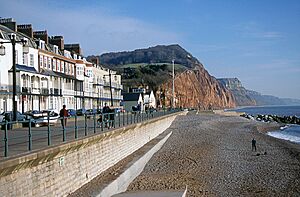
Churches and Museums
Sidmouth's main church is dedicated to St Giles and St Nicholas. It was rebuilt in 1860, but its 15th-century tower was kept. Inside, you can see the Duke of Kent Memorial Window, given by Queen Victoria in 1867.
The museum, next to the church, has many local items. You can see historical artifacts and interesting rocks. There are other churches in Sidmouth too, including Methodist and Catholic ones.
Sidmouth is also home to the Norman Lockyer Observatory and Planetarium. This place was finished in 1912. It's now a science education center and is open to the public. You can learn about stars and planets there!
Music and Festivals
Sidmouth Folk Week
Sidmouth Folk Week is a famous annual folk festival. It happens every August and brings musicians and visitors from everywhere. It's a big event with music, dancing, and fun for everyone.
Sidmouth Town Band
The Sidmouth Town Band is a brass band. During the summer, they play concerts in the Connaught Gardens every Sunday evening. The band has been around since at least 1862! They are very good and have won awards in competitions.
Sidmouth in Books and TV
Sidmouth has appeared in many books. For example, it's called "Stymouth" in Beatrix Potter's story The Tale of Little Pig Robinson. It's also the inspiration for "Idmouth" in Thomas Hardy's Wessex stories. The poet Elizabeth Barrett lived in the town for a few years.
J.R.R. Tolkien, the author of Lord of the Rings, visited Sidmouth often. He even wrote parts of the early Lord of the Rings story while on holiday here in 1938. Sidmouth was also used as a setting for TV shows, like an adaptation of Agatha Christie's Marple.
Other Interesting Facts
The Sidmouth Herald is the local newspaper. The Manor Pavilion is an arts center and theatre. It hosts both local and professional shows. There's also the Radway Cinema.
Sidmouth has often won awards in the Britain in Bloom competition. This shows how beautiful the town's gardens and flowers are. The Sid Vale Association, the first civic society in Britain, was started in Sidmouth in 1846.
In 2018, a very large "fatberg" (a huge mass of grease and waste) was found in Sidmouth's sewers. Scientists studied it, and it was removed and turned into energy!
Twin Towns
Sidmouth is twinned with Le Locle in Switzerland. This means they have a special friendship and connection.
Cool Places to See
The Esplanade is the sea front road. It stretches from the red cliffs of Salcombe Hill to Jacob's Ladder Beach. From here, you can see Peak Hill in the distance.
Jacob's Ladder is a set of wooden steps. They lead up to Connaught Gardens from Jacob's Ladder Beach. The beach is famous for its red cliffs.
Connaught Gardens were created around 1820. They were named after the Duke of Connaught. He was Queen Victoria's third son. He officially opened the gardens in 1934. Bands often play at the bandstand here during the summer.
The grassy slope on Peak Hill offers amazing views. You can look out over the whole town towards Salcombe Hill.
Sidmouth's Economy
Sidmouth's main income comes from tourism. There are many hotels, guest houses, and self-catering places to stay. Many retired people live in Sidmouth, and their spending also helps the local economy.
East Devon District Council used to be the largest employer here. There's also a big independent department store, Fields of Sidmouth. It has been in the same spot for over 200 years! You'll find pubs, restaurants, coffee shops, and tea rooms. Sidmouth also has an indoor swimming pool, a sports hall, and a golf course.
Education in Sidmouth
Sidmouth College is a comprehensive school. It teaches students aged 11 to 18. The college was rated 'Good' by Ofsted in 2012. It takes students from nearby towns like Exmouth and Exeter.
Sidmouth has one state junior school for children aged 8 to 11. There are also two state infant schools. A private school, St John's International School, teaches children from age two to 18. It also has students from other countries who live there.
Sidmouth International School is an English language school. It helps foreign students learn English.
Famous People from Sidmouth
- Stuart Hughes (politician)
- Edmund Leach (1910–1989), a social anthropologist who studied human societies.
- Adolph Friedrich Lindemann (1836–1931), an engineer who lived in Sidholme mansion.
- R. W. Sampson
|
See also
 In Spanish: Sidmouth para niños
In Spanish: Sidmouth para niños


